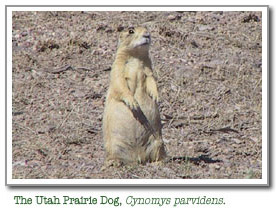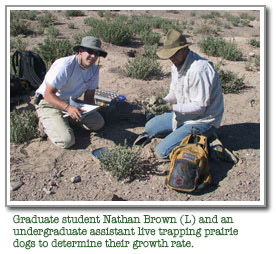Recovery of a Threatened Species: The Utah Prairie Dog
 Recovery plans for most threatened or endangered species are based on relatively simple population “viability analysis” that assumes the greatest risk arises from small total numbers of individuals and random changes in births and deaths in the population. This ignores that fact that most of these species live in fragmented, patchy habitats containing very small, high-risk populations. Furthermore, these patches may be unlikely to be colonized if they go “locally” extinct. Population viability analysis that assumes the total “metapopulation” is composed of small relatively isolated “local” populations has been developed theoretically and tested on some insect species, but has not been widely applied in the management of threatened and endangered species.
Recovery plans for most threatened or endangered species are based on relatively simple population “viability analysis” that assumes the greatest risk arises from small total numbers of individuals and random changes in births and deaths in the population. This ignores that fact that most of these species live in fragmented, patchy habitats containing very small, high-risk populations. Furthermore, these patches may be unlikely to be colonized if they go “locally” extinct. Population viability analysis that assumes the total “metapopulation” is composed of small relatively isolated “local” populations has been developed theoretically and tested on some insect species, but has not been widely applied in the management of threatened and endangered species.
 Utah prairie dogs are a small (0.5 – 1 kg) rodent restricted in distribution to a series of spatially isolated valleys and plateaus in southwestern Utah. Their extremely slow rate of colonization of colonies that have gone “locally” extinct through predation, poisoning, drought, and epizootics of bubonic plague makes them an almost classic metapopulation. Adults at all known Utah prairie dog locations have been counted since the mid-1970’s and these counts represent probably the bestspatially explicit population data for any mammal.
Utah prairie dogs are a small (0.5 – 1 kg) rodent restricted in distribution to a series of spatially isolated valleys and plateaus in southwestern Utah. Their extremely slow rate of colonization of colonies that have gone “locally” extinct through predation, poisoning, drought, and epizootics of bubonic plague makes them an almost classic metapopulation. Adults at all known Utah prairie dog locations have been counted since the mid-1970’s and these counts represent probably the bestspatially explicit population data for any mammal.
Several students and I have studied the effects of habitat and grazing on Utah prairie dog body growth, reproduction, and survival in the field and have analyzed patterns of fluctuation and local extinction for the whole species’ population. However, much work remains to link these studies with those by other researchers studying effects of plague to build a comprehensive metapopulation model for the Utah prairie dog that can be used in planning its recovery.
Selected Related Publications:
Ritchie, M.E. 1999. Biodiversity and reduced extinction risks in spatially isolated rodent populations.Ecology Letters 2: 11-16.
Ritchie, M.E., Zablan, M., Bodenchuk, M., Bolander, R., Bonebrake, R., Grandison, K., McDonald, K. 1997. Utah prairie dog interim conservation strategy. U.S. Fish and Wildlife Service, Salt Lake City, Utah, 25 pp
